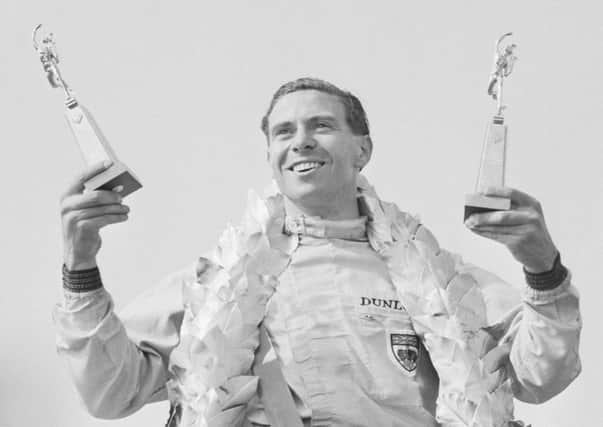Jim Clark - the '˜complete, natural-born driver'


That came at Germany’s Hockenheimring at the tragically young age of 32 and the Scot needn’t even have been there. Clark’s two main sponsors both laid claim to him that day. Ford wanted him to show off their brand new sports car at Brands Hatch. Lotus wanted him in the F2 race at Hockenheim.
In a prescient interview a few years earlier the Scot had been asked whether he thought about the dangers inherent in his lifestyle.
Advertisement
Hide AdAdvertisement
Hide Ad“I do, from time to time,” he admitted, “especially if there are trees about. If you go off you are going to hit them hard.”
Clark went off the Hockenheimring at high speed and the Scot hit the trees hard. Never the most robust racing car, the Lotus was in pieces and the man behind the wheel was pronounced dead in the ambulance.
It prompted a general outpouring of grief in a sport that had become all too accustomed to death. His boss, friend and father figure at Lotus, Colin Chapman, was nearly destroyed by the loss.
The cause of the crash has been debated endlessly and most accept that it was probably caused by a loss of pressure in a rear tyre. What no one could swallow was that Clark might have been responsible. As Jackie Stewart later noted, his one-time team-mate drove “smooth and clean, he never bullied the racing car”.
Clark raced for nine seasons in total. He won two F1 Championships, in 1963 and 1965, finishing second in 1962. He made pole in 33 of his 73 starts and he won 25 Grands Prix, a remarkable record of one win every three races.
If it is true that Chapman’s lightweight Lotus was probably the fastest car of its era, then it is only right to underline that it was far from the most reliable. Statistically speaking Clark suffered almost as many retirements (23) as he did victories (25) in his F1 career.
Several incidents illustrate why Clark deserves his place alongside the likes of Fangio, Senna and Schumacher. He won the British Grand Prix four times in succession but the 1965 race was a nail-biter and Clark was an inveterate biter of nails. After pulling out a substantial lead over Graham Hill’s Brabham, the Lotus began to lose oil pressure around the long sweeping bends. So Clark devised a plan to turn off the engine around the biggest bends and he gingerly nursed his car home 3.5 seconds ahead of Hill.
At Monza in 1967 Clark lost a lap while he had a tyre changed. Somehow he fought his way through almost the entire field to lead the race only to run out of fuel and coast over the finish line in third place. The knowledgeable Italian crowd pretty much ignored the winner and instead feted the brilliant Scot.
Advertisement
Hide AdAdvertisement
Hide AdTwo years earlier Clark had won at Belgium’s Spa track in biblical rain, lapping every car in the field bar one and finishing almost five minutes ahead of his nearest rival.
That was in 1965, which proved the high water mark of his career, the year he took his second F1 title and became the first foreign driver to win the the Indianapolis 500 since 1916. He won the gruelling Indy 500 by two clear laps in a record-breaking time of 3:19:05 at record breaking speed, the first driver to average more than 150mph.
The riches that came his way, including almost £900,000 (in today’s money) for the Indy 500, meant that Clark moved to Paris as a tax exile but he remained reassuringly Scottish when it came to money. There is one story about Clark and Hill visiting Las Vegas. The Englishman withdrew $1000 before hitting the tables, the Scot made do with $10… and told the story against himself.
The money was good but he earned it. In one week during that hectic 1965 season Clark flew from Rheims to Zurich on Monday for a sponsor’s lunch. He travelled from Zurich to Rouen for midweek practice before returning to the UK on Thursday and then winning the British Grand Prix on Saturday. Immediately after the race he hitched a lift in Chapman’s twin prop back to Rouen where he won Sunday’s French F2 race.
“Two wins in two days, not bad”, he wrote in his newspaper column. The Scot competed in 59 different races across the world throughout that one year.
But for all his success on the race track Clark’s enduring power to command affection has more to do with his human qualities than his racing prowess. He remained the “naif”, never forgetting his Borders roots. In the early years when he went racing with his great Borders pal Ian Scott-Watson, Clark artlessly asked, “why on earth is everyone driving so slowly?”
Once described as “very, very shy”, Clark was quiet, retiring, diffident, pedantic to a fault and almost entirely incapable of making up his mind on the trivia of daily life.
But once behind the wheel of a race car he morphed into a very different animal. His Lotus team-mate Trevor Taylor called him “a complete, born-natural” and the legendary racing journalist Peter Windsor called him “a genius among his peers. The Standard”.
Advertisement
Hide AdAdvertisement
Hide AdIn short he was a natural at the elegant simplicity of driving faster than anyone else alive.
“I don’t drive any faster, I just concentrate harder, which makes me go faster.”
That was how Clark defined his own brilliance behind a wheel and, if it falls a little short as an explanation, well, the Scot’s true strengths lay elsewhere.